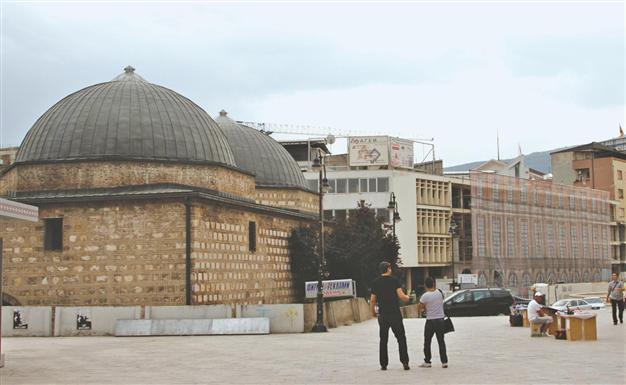Old Turkish bazaar to gain former grandeur
SKOPJE - Anadolu Agency

The historic Turkish bazaar in Skopje still stands with stores, fountains, inns and mosques like an Anatolian district. AA photos
Though somewhat dilapidated, the historic Turkish bazaar in the Macedonian capital, Skopje, still stands, two-stories tall, with stores, fountains, inns and mosques typical of an Anatolian district. Now, however, work is set to begin to restore the market to its previous state in an effort to draw even more tourists.Skopje, which served as a regional hub and city center after being conquered by the Ottomans in 1389, was one of the Balkans’ most important trade centers. One of the most beautiful examples of bazaars in the area, the market was one of the largest bazaars in the Balkans in the 17th century, drawing people from Bosnia, Montenegro, Serbia and Kosovo.
Like Anatolian
During the period prior to the dismemberment of Yugoslavia, trade would also continue at the bazaar around the clock at its location on the eastern side of the Vardar River.
Bearing strong resemblance to an archetypal Anatolian district, The Turkish bazaar has stood the test of time, with artworks located inside having survived to the present day.
The Turkish bazaar, which features wares ranging from clothing to food and souvenirs, is home to a significant collection of Ottoman artwork, including works at the Çifte Hamam, which serves as an art gallery. The facility also contains the Paşa, Dükkancık, Mustafa Paşa, İsa Bey, Yahya Paşa, İshak Bey and Alaca mosques, which remain open for worship.
 The Turkish language is spoken in the bazaar, where artisans still remain loyal to Turkey and the Ottomans. Besides its architectural structures, the lifestyle and habits are different in the bazaar compared with traditional lifestyles and habits in Anatolia.
The Turkish language is spoken in the bazaar, where artisans still remain loyal to Turkey and the Ottomans. Besides its architectural structures, the lifestyle and habits are different in the bazaar compared with traditional lifestyles and habits in Anatolia. A number of artisanal traditions are still practiced at the bazaar, such as coppersmith, quilting and filigree work.
The bazaar fell into a period of relative neglect after Macedonia declared independence in the early 1990s and began to reshape its identity. Later on, however, crafts were revived and saddlers and sandal stores were opened in the bazaar.
Macedonia’s government has passed a law and initiated a project to conserve and revive the bazaar. Within the scope of the project, works on the bazaar’s restoration are continuing in an attempt to transform it back to its former glory and revive traditional arts. When the project is completed, it is expected that the number of tourists visiting the bazaar will increase.
Turkish bazaar travel literature
In his “Seyahatname” (Book of Travels), Ottoman scholar Evliya Çelebi says he visited the bazaar when he was in Skopje between 1660 and 1661, adding that it had 2,150 stores and squares.
The traveler extraordinaire praised the cleanliness of the bazaar’s streets and pavements, while adding, “People that work there are both honest and educated.”
















